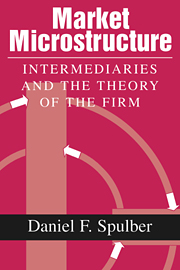Book contents
- Frontmatter
- Contents
- Preface and acknowledgments
- Introduction
- Part I Market microstructure and the intermediation theory of the firm
- Part II Competition and market equilibrium
- Part III Intermediation versus decentralized trade
- Part IV Intermediation under asymmetric information
- 7 Adverse selection in product markets
- 8 Adverse selection in financial markets
- Part V Intermediation and transaction-cost theory
- Part VI Intermediation and agency theory
- Conclusion
- References
- Index
8 - Adverse selection in financial markets
Published online by Cambridge University Press: 18 December 2009
- Frontmatter
- Contents
- Preface and acknowledgments
- Introduction
- Part I Market microstructure and the intermediation theory of the firm
- Part II Competition and market equilibrium
- Part III Intermediation versus decentralized trade
- Part IV Intermediation under asymmetric information
- 7 Adverse selection in product markets
- 8 Adverse selection in financial markets
- Part V Intermediation and transaction-cost theory
- Part VI Intermediation and agency theory
- Conclusion
- References
- Index
Summary
Intermediaries supply many types of information to their customers and suppliers. Often the information is bundled with the other services that are provided to customers and suppliers. Intermediaries, such as retailers, inform their customers about product characteristics. Intermediaries also relay information about market demand and customer requirements to their suppliers. If there are returns to scale in producing and distributing this information, there are benefits from consolidating transactions through intermediaries. In this chapter, I examine how intermediaries cope with and alleviate adverse selection.
Asymmetric information affects the returns to intermediation activities in several crucial ways. Asymmetric information about willingness to pay and opportunity costs creates inefficiencies in bilateral trade, causing efficiency distortions in the amount traded or even the breakdown of trade that would have been mutually beneficial. In this case, there are returns to intermediation by the firm as a designer of allocation mechanisms as observed in Chapter 7. The returns to intermediation are reduced by the information rents that must be given to buyers and sellers to induce truthful revelation. Intermediaries, after all, often face the same asymmetries of information that trouble individual sellers.
Asymmetric information can create losses for the intermediary if some agents are better informed about the value of the assets that are being exchanged. The intermediary compensates for expected losses by extracting rents from less-informed agents. Adverse selection has a specific effect on the bid–ask spread in financial markets; see Copeland and Galai (1983) and Glosten and Milgrom (1985).
- Type
- Chapter
- Information
- Market MicrostructureIntermediaries and the Theory of the Firm, pp. 203 - 226Publisher: Cambridge University PressPrint publication year: 1999



